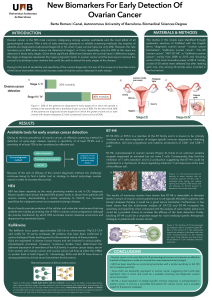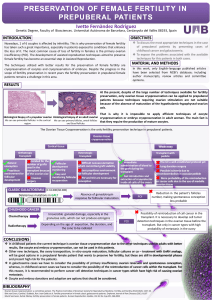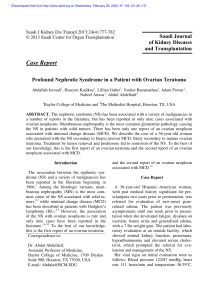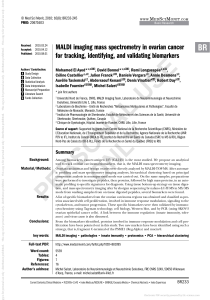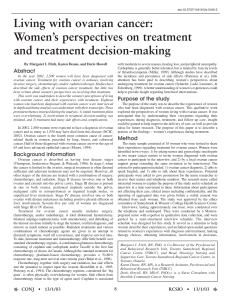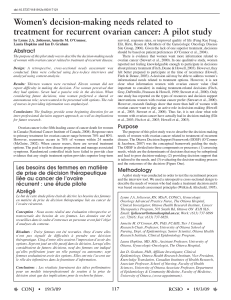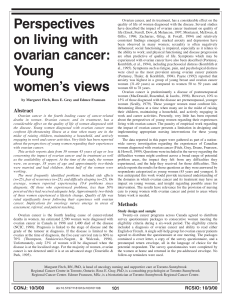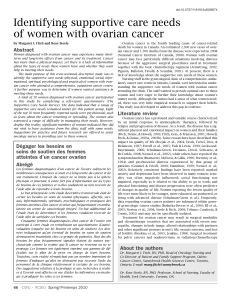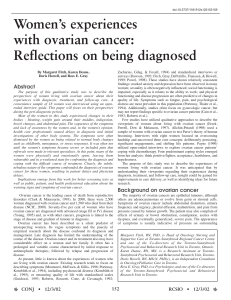10 MALDI-MSI and Ovarian Cancer Biomarkers
publicité
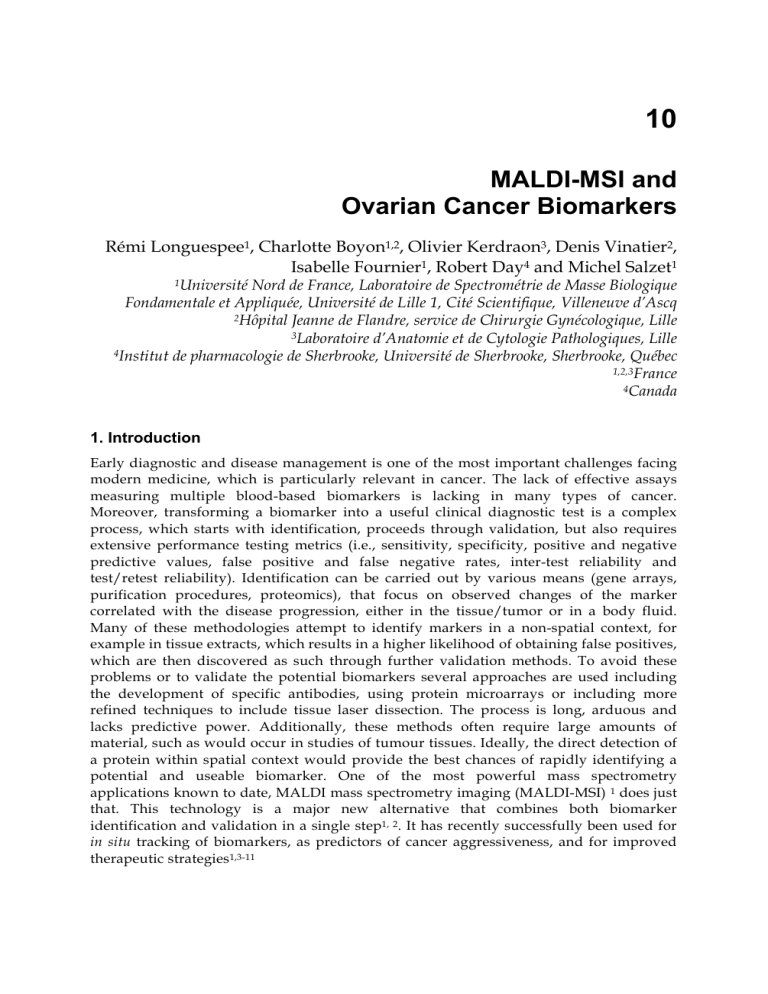
10
MALDI-MSI and
Ovarian Cancer Biomarkers
Rémi Longuespee1, Charlotte Boyon1,2, Olivier Kerdraon3, Denis Vinatier2,
Isabelle Fournier1, Robert Day4 and Michel Salzet1
1Université Nord de France, Laboratoire de Spectrométrie de Masse Biologique
Fondamentale et Appliquée, Université de Lille 1, Cité Scientifique, Villeneuve d’Ascq
2Hôpital Jeanne de Flandre, service de Chirurgie Gynécologique, Lille
3Laboratoire d’Anatomie et de Cytologie Pathologiques, Lille
4Institut de pharmacologie de Sherbrooke, Université de Sherbrooke, Sherbrooke, Québec
1,2,3France
4Canada
1. Introduction
Early diagnostic and disease management is one of the most important challenges facing
modern medicine, which is particularly relevant in cancer. The lack of effective assays
measuring multiple blood-based biomarkers is lacking in many types of cancer.
Moreover, transforming a biomarker into a useful clinical diagnostic test is a complex
process, which starts with identification, proceeds through validation, but also requires
extensive performance testing metrics (i.e., sensitivity, specificity, positive and negative
predictive values, false positive and false negative rates, inter-test reliability and
test/retest reliability). Identification can be carried out by various means (gene arrays,
purification procedures, proteomics), that focus on observed changes of the marker
correlated with the disease progression, either in the tissue/tumor or in a body fluid.
Many of these methodologies attempt to identify markers in a non-spatial context, for
example in tissue extracts, which results in a higher likelihood of obtaining false positives,
which are then discovered as such through further validation methods. To avoid these
problems or to validate the potential biomarkers several approaches are used including
the development of specific antibodies, using protein microarrays or including more
refined techniques to include tissue laser dissection. The process is long, arduous and
lacks predictive power. Additionally, these methods often require large amounts of
material, such as would occur in studies of tumour tissues. Ideally, the direct detection of
a protein within spatial context would provide the best chances of rapidly identifying a
potential and useable biomarker. One of the most powerful mass spectrometry
applications known to date, MALDI mass spectrometry imaging (MALDI-MSI) 1 does just
that. This technology is a major new alternative that combines both biomarker
identification and validation in a single step1, 2. It has recently successfully been used for
in situ tracking of biomarkers, as predictors of cancer aggressiveness, and for improved
therapeutic strategies1,3-11
212
Advances in Cancer Management
2. MALDI Mass Spectrometry Imaging (MALDI-MSI)
Over these past ten years, important technical improvements in mass spectrometry
instrumentation together with the growing importance of this method for compound
identification had lead to the development of direct analysis of tissue samples. Mass
spectrometry has become an analytical tool allowing identification of compounds directly
from tissues without any extraction or separation and adding the essential and time saving
spatial resolution to the analysis. Furthermore, in a single experiment, molecular
information on hundreds of chemical or biological molecules can be retrieved. By
automation of this method and powerful data processing, molecular maps are generated
from single tissue sections. Another major advantage is the sensitivity of mass spectrometry
instruments giving access to hundreds of compound molecular images after one set
acquisition. Matrix-assisted laser desorption/ionization (MALDI) ion sources are well suited
for this application as they can provide data on a range of biomolecular families ranging
from small molecule drugs, peptides, proteins, oligonucleotides, sugars or lipids with a
spatial resolution that approaches near cellular resolution. MALDI-imaging mass
spectrometry (MALDI-MSI) was first introduced by Caprioli and coll.12 but major
improvements have been developed in by other groups seeking to improve sample
preparations, instrumentation, image spatial resolution , as well as develop new fields of
applications2,12-14. For example, MALDI-MSI technology has been used for biomarkers
hunting, drug biodistribution tissue interactions in drug discovery as well as for the
molecular diagnosis through biopsy analyses in pathology. The translational nature of this
technology provides unique challenges and as yet unimagined opportunities that promise to
transform the way disease is detected, treated, and managed.
Rather than focusing on genetic alterations that may lead to a particular disease, it is
emerging that changes in protein expression patterns are the most accurate way to identify
diseases in their early stages and to determine the most effective course of treatment.
Indeed, genome sequences fails to provide certainty for post-translational modification
events such as glycosylation, phosphorylation, acylation or partial proteolysis. One of the
most common objectives in proteomics is the study of protein expression patterns (e.g.,
protein profiling) associated with diseases. Pathologies that cause changes in signal
transduction pathways generally result in changes in specific cell phenotypes. Using
MALDI-MSI in this context does not have knowledge prerequisite of the studied system due
to the non-targeted nature of the analysis. Such data leads to the establishment of a
classification of cell phenotypic changes at the molecular level and in this way can provide a
better understanding of pathologies, can lead to new diagnostic biomarkers or even new
therapeutic targets. The capacity of generating multidimensional pictures with a spatial
resolution that can approach the cellular level, allows monitoring, in the same analysis, of
the localization of drugs compounds and the changes in biomarkers expression2.
In the context of the present discussion, there is a single clear advantage of MALDI_MSI,
that is the spatial localization of identified compounds, that tremendously increases the
predictive potential of which markers are most likely to be successful at the clinical level.
There are additional advantages to the MALDI-MSI approach for biomarker hunting.
MALDI ion sources can identify a wide range of biomolecular families including small
molecule drugs, peptides, proteins, sugars or lipids with a spatial resolutions that
approaches the cellular level. Due to its high data acquisition, MALDI_MSI can permit the
establishment of a classification of cell phenotypic changes at the molecular level, which can
MALDI-MSI and Ovarian Cancer Biomarkers
213
be used to complement histology techniques. The correlation between molecular images
obtained by MALDI-MSI and the ones obtained by pathologists using classical
histocytochemistry can be inclusive of all grades, stages, cancer types, and cell types.
However, differently from classic histocytochemistry, MALDI-MSI allows identification at
the molecular level, in each cell type. Combined with powerful multivariate analyses like
the hierarchical classification and principal component analyses (PCA)5, it is possible to
identify biomarkers present in carcinoma region from one in a stromal area, from those in an
interstitial region. Therefore, in a single analysis we can access multiple biomarkers present
in a region of interest, characterize them in situ, without any tissue extraction. In regards to
cancer tissues, which most often are high heterogeneous, the combination of MALDI_MSI
and multivariate analyses are the most powerful and suited tools developed to date.
Consequently, we propose that biomarkers uncovered using MALDI-MSI will be more
clinically useful than those uncovered by standard methods, such as gene arrays or tissue
extraction/fractionation, which lack spatial context. Other predictions also follow from this
logic, as biomarkers are known for their potential roles in a disease’s etiology. It therefore
follows that they may well represent important therapeutic targets.
In the present chapter, we will focus on a single example, namely in ovarian, cancer, to
establish the usefulness of MALDI MSI technology for tracking and validating new
biomarkers.
3. Ovarian cancer
Ovarian cancer is the fourth leading cause of cancer death among women in Europe and the
United States. Among biomarkers, cancer-antigen 125 (CA-125) is the most studied. CA-125
has a sensitivity of 80% and a specificity of 97% in epithelial cancer (stage III or IV, (Table 1,
Figure 1)). However, its sensitivity is around 30% in stage I cancer, its increase is linked to
Fig. 1. Hematoxilin eosin staining of different type’s of ovarian cancer and benign tissues.
214
Advances in Cancer Management
several physiological phenomena and it is also detected in benign situations15. CA-125 is
particularly useful for at-risk population diagnosis and following disease progression
during therapeutic treatment. In this context, CA-125 is insufficient as a single biomarker for
ovarian cancer diagnosis. The alternative is to identify additional biomarkers, using a
proteomic strategy, that can better etablish the diagnosis and prognosis in regards to the
tumor stage (Table 2)16-24. Presently, two strategies have been established. First has been the
attempt to identify ovarian cancer markers in plasma SELDI-TOF profiling or
chromatography coupled to mass spectrometry17,25-30. Second, has been the development of
classic proteomic strategies using comparative 2D-gels and mass spectrometry24,31-33 or using
genomic methodologies (Table 3).
FIGO STAGE
TNM FIGO
Description
TX
Non evaluable primitive Tumor
T0
No ovarian lesion
Prevalence
% of survey after 5
years treatment
T1
Stage I
Tumor limited to the ovary
T1a
Ia
Unilateral, capsule intact, no ascite
80%
T1b
Ib
Bilateral, capsules intact, no ascite
75%
T1c
Ic
Limited to ovaries but presence of ascite
70%
T2
Stage II
Tumor limited to the pelvis
T2a
IIa
Extensions limited to the uterus and the
ducts
60%
T2b
IIb
Extensions to the other pelvic issues
65%
T2c
IIc
Extensions to the other pelvic issues
with ascites
65%
T3
Stage III
Tumor limited to the abdomen
T3a
IIIa
Peritoneal microscopic extension
40%
T3b
IIIb
Peritoneal implants less than 2 cm
25%
T3c
IIIc-p
Peritoneal implants more than 2cm
20%
N1
IIIc-g
Lymphatic ganglia colonized: subpelvis, para-aortic and inguinal
<10%
M1 Stage IV
Metastasis at distance and pleural
effusion
25%
11%
47%
17%
<10%
Table 1. Grading systems of epithelial carcinoma. FIGO 1995: Universal grading
nomenclature.
215
MALDI-MSI and Ovarian Cancer Biomarkers
Marker Name
Mesothelin-MUC16
Genomic Proteomic MALDI
Imaging
99
STAT3
99
LPAAT-β (Lysophosphatidic acid acetyl transferase beta)
100
Inhibin
101
Kallikrein Family (9, 11, 13, 14)
102
Tu M2-PK
103
c-MET
104-106
MMP-2, MMP-9, MT1-MPP: Matrix metalloproteinase
107-109
EphA2
110-112
PDEF (prostate-derived Ets factor)
63, 113
IL-13
114
MIF (Macrophage inhibiting factor)
63, 113
NGAL (Neutrophil gelatinase-associated lipocalin)
115
CD46
116-118
RCAS 1 (Receptor-binding cancer antigen expressed on
SiSo cells)
64, 119
Annexin 3
120
Destrin
121, 122
5
5
5
Cofilin-1
123
GSTO1-1
121, 122
IDHc
121, 122
FK506 binding protein
124
Leptin
125, 126
Osteopontin
120
insulin-like growth factor-II
127
Prolactin
128
78 kDa glucose-regulated protein
129
Calreticulin
129
Endoplasmic reticulum protein ERp29
129
Endoplasmin
129
Protein disulfideisomerase A3
129
Actin, cytoplasmic 1
129
Actin, cytoplasmic 2
129
Macrophage capping protein
129
Tropomyosin alpha 3 chain, alpha-4 chain
129
216
Advances in Cancer Management
Marker Name
Genomic Proteomic MALDI
Imaging
Vimentin
129
Collagen alpha 1(VI) chain
129
Dihydrolipoyllysineresidue succinyltransferase
component of 2-oxoglutarate dehydrogenase
129
Pyruvate dehydrogenase E1 component beta
129
Superoxide dismutase [Cu-Zn]
129
Chromobox protein homologue 5
129
Lamin B1, B2
129
14-3-3 protein
129
Cathepsin B
129
Heterogeneous nuclear ribonucleoprotein K
129
Nucleophosmin
129
Peroxiredoxin 2
129
Prohibitin
129
Receptor tyrosine-protein kinase erbB-3
129
Fibrinogen gamma chain
129
Splicing factor, arginine/serine-rich 5
129
Elongation factor 1-beta
129
Lysosomal protective protein
129
Hemoglobin beta subunit
129
Transitional endoplasmic reticulum ATPase
129
Serum albumin
129
Protein KIAA0586
129
Similar to testis expressed sequence 13A
129
SNRPF protein
129
Fibrinogen gamma chain
129
Transitional endoplasmic reticulum ATPase
129
Heat shock 70 kDa protein 1, 60K protein
129
Heterogeneous nuclear ribonucleoprotein K
129
Keratin, type I cytoskeletal 7, 9, 18, 19 ?
129
Adenylosuccinate lyase
129
Peroxiredoxin 2
129
Glutathione S-transferase P
129
Ras-related protein Rab-7
129
Prohibitin
129
5
5
217
MALDI-MSI and Ovarian Cancer Biomarkers
Marker Name
Genomic Proteomic MALDI
Imaging
Cathepsin B
129
Heterogeneous nuclear ribonucleoprotein K
129
Tumor protein D54
129
Rho GDPdissociation inhibitor 1
129
Annexin A2
129
ATP synthase beta chain
129
Heterogeneous nuclear ribonucleoprotein K
129
Actin, cytoplasmic 1
129
Heterogeneous nuclear ribonucleoprotein A/B
129
Immunoprotease activator fragment 11 S
7
Mucin-9
5
Tetranectic
5
Urokinase plasminogen activator
5
Orosomucoid
5
S100-A2
5
S100-A11
5
Apolipoprotein A1
5
Transgelin
5
Prolargin
5
Lumican Precursor
5
Siderophilin
5
Alpha 1 antiprotease
5
Phosphatidyl Ethanolamine Binding Protein
5
Hemopexin
5
Profilin -1
5
Table 2. Biomarkers identified by genomic, classical proteomic or SELDI approaches.
Protein
Patient 1
VE2-HPV36
X
VE2-HPV39
Patient 2
Patient 3
Virus
X
HPV
X
VE6-HPV56
HPV
X
HPV
UL16-EBV
X
X
X
EBV
UL11-EBV
X
X
X
EBV
Table 3. Viral protein detected in patients tumor by NanoLC-IT MS/MS.
218
Advances in Cancer Management
Our group has taken a different approach, attempting direct tissue analysis and peptide
profiling followed by MALDI profiling and imaging1,3-11,34-38. Ovarian carcinomas (stages III
and IV) and benign ovaries were directly analyzed by MALDI-TOF-MS after three different
treatments for proteins, high hydrophobic proteins and peptides extraction. Hierarchical
clustering based on principal component analysis (PCA) as well as PCA-Symbolic Discrimant
Analysis (SDA)34 was carried out using ClinProTools software to classify tissues. Principal
component analysis was used in the unsupervised mode to differentiate tumors and healthy
spectra based on their proteomic composition as determined by MALDI-MSI. These
characterized proteins can be grouped into functional categories such as cell proliferation,
immune response modulation, signaling to the cytoskeleton, and tumor progression1,5,7,37.
4. Proteins involved in immune response modulation
Recent studies have shown that ovarian cancer-associated ascites may provide an
immunosuppressive environment39 (Figure 2). A high CD4/CD8 ratio, which may indicate
the presence of regulatory T-cells, is associated with poor outcomes. Recently, Clarke et al.40
have validated in a cohort of 500 ovarian cancer patients that the presence of intraepithelial
CD8+T-cells correlates with improved clinical outcomes for all stages of ovarian cancer.
Curiel et al. demonstrated in 104 ovarian cancer patients that CD4+CD25+FoxP3+ Tregs
suppress tumor-specific T-cell immunity and contribute to growth of the tumor in vivo41.
These data point to a mechanism of immune suppression in ovarian cancer either by overexpression of Tregs or by the tumor itself by escaping the immune response by molecular
mimicry or by escaping immunosurveillance42,43. Additional eveidence has reinforced the
involvement of Tregs in ovarian cancer. CCL22, a protein secreted by dendritic cells and
macrophages, highly expressed in tumor ascites is known to have a role in Treg cell
migration in tumors41. Over-expression of the immunoregulatory enzyme indoleamine 2,3dioxygenase (IDO) has also been demonstrated in ovarian cancer44-47. IDO suppresses the
proliferation of effector T cells or natural killer cells and their killer functions45,48. In ovarian
cancer, high IDO expression in tumor cells was correlated with a reduced number of tumorinfiltrating lymphocytes44. Reduced IL-2 and elevated TGF-β and IL-10 levels favor induced
Tregs49. On the other hand, tumor cells escape the immune response by inducing peripheral
mature DCs toinduce IL-10 CCR7+CD45RO+CD8+Tregs. Primary suppressive
CCR7+CD45RO+CD8+ T cells are found in the tumor environment of patients with ovarian
cancer50. Another way that tumor cells escape immunosurveillance is through the
expression of Human Leukocyte antigen (HLA-G)51,52,53{Sheu, 2007 #5782. Recent studies have
shown that the expression of HLA-G was detected in 22/33 (66.7%) primary tumor tissues,
but was absent in normal ovarian tissues (P<0.01). Cytotoxicity studies showed that HLA-G
expression dramatically inhibits cell lyses by NK-92 cells (P<0.01), which could be restored
by the anti-HLA-G conformational mAb 87G (P<0.01). HLGA-G5 type has been detected in
tumor and soluble form of HLA-G in ascites54,55 and in the blood of patients56. HLA-G seems
to be implicated in the immune response modulation through NKT cell inhibition57. In the
tumor cells expressing a B7 costimulatory family molecule, B7H4 is known to inhibit
antigen-dependent induction of T cell proliferation and activation. B7-H4 promotes the
malignant transformation of epithelial cells by protecting them from apoptosis and seems to
be expressed at an early stage of the tumor58-60. In the same way, tumor cells highly express
the mesothelin-Mucin 16 (MUC16) which inhibits the formation of immune synapses
between NK cells and ovarian tumor targets61.
MALDI-MSI and Ovarian Cancer Biomarkers
219
Fig. 2. Immune suppressive pathways in ovarian cancer.
Tregs are attracted to the tumor environment by CCL22 secreted by the tumor. Tregs
inhibits CD4+, CD8+ via direct contact or by secretion of IL10 and TGF-β. NKT cells are
inhibited by sHLA-G, MUC16, RCAS1 and MIF produced by the tumor and by IDO
produced by Tregs. MIF acts through NKGD2 activation on NKT cells. The tumor
environment expresses molecules that can convert functional APCs into dysfunctional ones.
These dysfunctional APCs in turn stimulate Treg differentiation and expansion. The tumor
produce IL6, IL8, pDcs are present in tumor environment and stimulate tumor growth by
releasing TNF-α and IL8. IL6, IL10 are produced by Tregs and stimulate B7H4 expression in
macrophages leading T-cell cycle arrest. IL10, TGF-b suppress APC function by inhibiting
the expression of CD80, CD86.
Transcriptomic and proteomic studies perform at the level of the tumors confirm the active
role of the tumor cells to escape the immune response. Transcriptomic studies have shown
the over-expression of the macrophage migration inhibitory factor (MIF)62,63, Receptorbinding cancer antigen expressed on SiSo cells64 known to be implicated in lymphocytes
apoptosis. MIF contributes to the inhibition of antitumoral CD8+ T and NK cells by downregulation of NKG2D (NK cell receptor NK group 2D)65.
From our MALDI-MSI studies, five factors involved in immune response modulation in
mucinous tumors have been identified, namely a C-terminal fragment of the 11S
immunoproteasome (Reg-alpha) (Figure 3), orosomucoid, apolipoprotein A1, hemopexin,
and lumican which have also been detected in ascites1,5,7,36,37.
220
Advances in Cancer Management
Fig. 3. Immunocytochemical studies with polyclonal antibody rose against the c-terminal
part of Reg alpha.
a. Epithelial cells of immunolabeled differentiated endometrioid carcinoma
b. Epithelial cells of immunolabeled in carcinoma region
c. Cytoplasmic epithelial cells immunolabeling of nondifferentiated endometrioid
carcinoma.
d. Epithelial cells of immunolabeled in clear cells adenocarcinoma (mesonephroma)
e. Nuclear epithelial cells immunolabeling of benign tumor
f. Nuclear epithelial cells immunolabeling of adenofibromatous tumor
PSME1 (proteasome activator complex subunit 1, 11S regulator complex [syn: PA28 alpha])
cleaved into the Reg-alpha fragment could lead to default self-antigen presentation7. PA28 is
a regulatory complex associated with 20S proteasome that consists of 3 subunits: alpha, beta,
and gamma66. Binding of the 11S regulator complex to the 20S proteasome does not depend
MALDI-MSI and Ovarian Cancer Biomarkers
221
on ATP hydrolysis and unlike the 19S regulatory subunit, the 11S regulator complex does
not catalyze degradation of large proteins. Rather, it is responsible for MHC-class l antigen
processing,67-69 which is greatly improved by interferon gamma-induced expression of the
alpha and beta subunits70.
Several viral proteins that interact with these proteasome subunits have been reported, and
may interfere with host anti-viral defenses, thereby contributing to cell transformation71.
The manner in which they bind to the core particle via its subunits' C-terminal tails, and
induce an α-ring conformational change to open the 20S gate, suggests a mechanism similar
to that of the 19S particle66. No role in ovarian cancer has been demonstrated for the 11 S
regulator complexes. Our data demonstrate a high level of expression of PA28 in
carcinomas, especially in epithelial cells at stage III/ IV but also at early stages Ia (Figure 4).
Fig. 4. C-terminal fragment of Reg alpha dectection in stage Ia of ovarian cancer.
a. Hematoxilin eosing staining of the carcinoma cell (acini)
b. Hematoxilin eosin staining of the benign region
c. Immunocytochemical studies with polyclonal antibody rose against the c-terminal part
of Reg alpha
d. MALDI mass spectra obtained from carcinoma cell and from the benign region. The
data point out the detection of the m/z of 9744 in carcinoma region in line with the
immunocytochemical data.
222
Advances in Cancer Management
The PA28 activator belongs to the antigen processing machinery (APM). Its alteration by
cleavage in ovarian carcinomas may be a mechanism to evade immune recognition. Such a
hypothesis has already been proposed for the case of APM chaperones such as TAP, LMP2,
LMP10, and tapasin in colon carcinoma, small cell lung carcinoma, and pancreatic
carcinoma cell lines. In fact, IFN-γ treatment of these carcinoma cell lines corrects the TAP,
LMP, and tapasin deficiencies and enhances PA28 α, LMP7, calnexin and calreticulin
expression, which is accompanied by increased levels of MHC class 1 antigens72. Recently,
PSEM2 (proteasome activator complex subunit 2, PA28 Beta) has also been detected in
ascites fluid, implicating its immune cell tolerance toward carcinoma cells and confirms the
dysregulation of self-antigen processing in ovarian tumors73. Additionally, PA28 alpha
seems to be a target for Epstein-Barr virus (EBV) and herpes virus (HV), as our proteomic
and qPCR data indicates (Tables 3 and 4). Pudney and colleagues74 have also shown that as
EBV-infected cells move through the lytic cycle, their susceptibility to EBV-specific CD8+ Tcell recognition falls dramatically, concomitant with a reduction in transporter associated
with antigen processing (TAP) function and surface human histocompatibility
leukocyte antigen (HLA) class 1 expression. The implication of virus in the ethiology of
ovarian cancer is also sustained by the over-expression of furin enzyme (Figure 5), which is
known to be implicated in glycoprotein B cleavage through a motif R-X-K/R-R in both EBV
and HV75,76.
Tumor Type
EBV
HHV6
(DNA copies/ng tumors) (DNA copies/ng tumors)
Carcinoma
Serous adenocarcinoma
1.56
0.82
Mucous adenocarcinoma
0.37
0.10
Cytadenoma Carcinoma
0.28
1.16
Adenomacarcinoma highly infiltrated
1.14
0.37
Adenomacarcinoma clear cells
1.46
Benign
Fibrous cytadenoma Benign
Fibrous cytadenoma Benign
Serous Cyst Benign
Yellow body hemorrhagic
Table 4.Viral DNA quantify by qPCR per ng of tissue.
Fig. 5. RT-PCR amplification of prohormone convertase enzymes from serous stage III/IV
carcinoma tissues.
MALDI-MSI and Ovarian Cancer Biomarkers
223
Among the other four factors that might participate in the tolerance phenomenon by
inhibiting immune activation, the acute phase protein, orosomucoid (ORM, also known as
alpha1-acid glycoprotein or AGP), is normally increased in infection, inflammation, and
cancer, and it seems to have immunosuppressive properties in ovarian carcinoma ascites
through inhibition of IL-2 secretion by lymphocytes77. Similarly, apolipoprotein A1 has been
detected in conjunction with transthyretin and transferrin in early-stage mucinous tumors78.
ApoA-I is known to decrease expression of surface molecules such as CD1a, CD80, CD86,
and HLA-DR in dendritic cells, and it stimulates the production of IL-1079.
Interestingly, hemopexin has recently been demonstrated to reduce TNF α and IL-6 from
macrophages during inflammation and limits TLR4 and TLR2 agonist-induced macrophage
cytokine production80. We demonstrate that in SKOV-3 epithelial ovarian carcinoma cells,
all TLRs are over-expressed with the exception of TLR9 and TLR10 (Figure 6). This is in line
with the over-expression of lumican, which is a small LRR proteoglycan in the extracellular
matrix. Along with other proteoglycans, such as decorin, biglycan, and prolargin, lumican is
known to be over-expressed in breast cancer and to play a role in tumor progression81,82.
However, as demonstrated for biglycan, which interacts with TLR2/4 on macrophages83,84,
we speculate that lumican is also involved in the activation of the inflammasome through
TLR2/4 interaction. The activation of all danger-sensing receptors in carcinoma cells can be
explained through the regulation of inflammation by carcinoma cells to facilitate tumor
progression. In a sense, this implies that ovarian cancer cells act as “parasites” and use
molecular mimicry85 to escape the immune response, as they produce immunosuppressors
to achieve tolerance (Figure 7).
Fig. 6. RT-PCR amplification of Toll-like receptors from serous stage III/IV carcinoma tissues.
5. Proteins associated with cell proliferation
The S100 protein family has been previously detected in aggressive ovarian tumors30. In our
study, we detected S100 A11 and S100 A12 proteins. S100 A11 has been detected in ovarian
ascites73. S100 A11 (or calgizzarin) is known to regulate cell growth by inhibiting DNA
synthesis86,87. S100 A12 is known to contribute to leukocyte migration in chronic
inflammatory responses88. In conjunction with S100 proteins and cytoskeleton modifying
proteins, we also detected expression of oviduct-specific glycoprotein (OGP, Mucin-9), a
marker of normal oviductal epithelium. Our data are supportive of Woo and associates, who
found that OGP is a tubal differentiation marker and may indicate early events in ovarian
carcinogenesis. These data also support the hypothesis of oviduct ascini as the origin of
serous ovarian carcinoma.
From immune components, stromal cell-derived factor-1 (SDF-1), the ligand of the CXCR4
receptor, is a CXC chemokine that induces proliferation in ovarian cancer cells by increasing
the phosphorylation and activation of extracellular signal-regulated kinases (ERK)1/2,
which in turn is correlated to epidermal growth factor (EGF) receptor transactivation.
224
Advances in Cancer Management
Fig. 7. Tumor cell factors production for escaping immune response.
Apolipoprotein A1 has been detected in conjunction with transthyretin and transferrin in
early-stage mucinous tumors. Lumican, which is a small LRR proteoglycan in the
extracellular matrix is known to be overexpressed in breast cancer and to play a role in
tumor progression. ApoA-I is known to decrease expression of surface molecules such as
CD1a, CD80, CD86, and HLA-DR in dendritic cells, and it stimulates the production of IL-10
hemopexin has recently been demonstrated to reduce TNF and IL-6 from macrophages
during inflammation, and it limits TLR4 and TLR2 agonist-induced macrophage cytokine
production. Orosomucoid have immunosuppressive properties in ovarian carcinoma ascites
through inhibition of IL-2 secretion by lymphocytes. The tumor environment expresses
molecules that can convert functional APCs into dysfunctional ones. These dysfunctional
APCs in turn stimulate Treg differentiation and expansion. The tumor produces IL6, IL8,
MUC18, MIF, RCAS1, sHLA-G exerting negative effects on the T-Cells. PA28 activator
belongs to the antigen processing machinery (APM). Its alteration by cleavage by (furin,
PACE4) in ovarian carcinomas participates in a mechanism to evade immune recognition.
Similarly, TGF-β produced by Treg cells stimulates tumor cell proliferation and increases
matrix metalloproteinase’s (MMP) production and enhances invasiveness of ovarian cancer
cells89-93. In ovarian cancer, IL7 acts as a growth factor, like in breast cancer, and has been
found in ascites and plasma39,94,95. pDcs are also present in tumor environment and stimulate
tumor growth by releasing TNF-α and IL8. The sum of these data reflect that cytokines exert
pleiotropic effects in ovarian cancer and exert a major role in tumor proliferation.
MALDI-MSI and Ovarian Cancer Biomarkers
225
6. Signaling to the cytoskeleton
Several candidate proteins, including profilin-1, cofilin-1, vimentin, and cytokeratin 19 are
involved in the intracellular signaling to the cytoskeleton. Changes in cell phenotype, such as
the conversion of epithelial cells to mesenchymal cells, are integral not only to embryonic
development but also to cancer invasion and metastasis. Cells undergoing the epithelialmesenchymal transition (EMT) lose their epithelial morphology, reorganize their
cytoskeleton, and acquire a motile phenotype through the up- and down-regulation of
several molecules, including tight and adherent junction proteins and mesenchymal markers.
TGF-β has been described to induce EMT in ovarian adenosarcoma cells96. (Figure 8A)
Figure 8.
A: Schematic illustration of E-cadherin, SIP1, Snail, Slug and Twist during ovarian
progression. In this model, epithelial ovarian tumors have been classified into two broad
categories: type I tumors including low-grade serous carcinomas, mucinous, endometrioid,
and clear cells carcinomas seem to develop from their precursors, namely borderline ovarian
tumors (BOTs), in a stepwise manner; type II including high-grade serous malignancies
develop from the OSE or inclusion cysts without a common precursor.OSE cells covering
the ovarian surface do not express E-cadherin but are positive for Snail and Twist
expression. As depicted, E-cadherin expression changes during ovarian cancer progression
showing an inverse correlation compared to SIP1, Snail, Slug and Twist expression93.
B: A simplified overview of signalling network regulating EGF-induced EMT. In OSE cells,
activation of the EGF receptor tyrosine kinases (RTKs) by EGF results in activation of the
phosphatidylinositol 3-kinase (PI3K), which activates ILK and ERK pathways. EGF treated
OSE cells display a molecular signature characteristic of EMT and are less likely to undergo
a conversion in inclusion cysts.JAK/STAT3 pathway is required to induce EMT in ovarian
cancer cells. Ovarian cancer cells that undergo EMT lose the expression of E-cadherin and
NGAL and show an increased motility.
226
Advances in Cancer Management
In the human lung adenocarcinoma cell line A549, this differentiation is accompanied by
modification in the expression of several cytoskeleton proteins including β-actin, cofilin 1,
moesin, filamin A and B, heat-shock protein beta-1, transgelin-2, S100 A11, and calpactin.
These changes presumably increase migratory and invasive abilities97. We recently
demonstrated that treatment of the ovarian cancer cell line SKOV-3 with TGF-β (10 ng/mL,
24 h) increases the expression of cofilin and profilin-1 at mRNA and protein level, and
modifies its cytoskeletal organization as assessed by confocal microscopy analysis98. After
binding to its receptor, TGF-β stimulates the reorganization of the actin cytoskeleton and
triggers the formation of stress fibers and cellular protrusions98 (Figure 8B).
7. Conclusion
A decade after its inception, MALDI-MSI has become a unique technique in the proteomic
arsenal for biomarker hunting in a variety of diseases. In this report, we consider the
contributions of MALDI-MSI and profiling technologies to clinical studies compared to the
ones obtained by genomic and classical proteomic. A stringent analysis of the list of
potential biomarkers detected by three technologies reflects little convergence between
genomic and proteomic (classical and MALDI MSI) investigations by biomarker
comparison. However, when integrating theses biomarkers in biological process, a real
convergence can be shown. What emerges is picture showing how tumors modulate and
escape the immune response. In this context, several biomarkers can be detected. Similarly,
immune tolerance forced by the tumor production and interaction with the immune cells
also revealed, in ascites and in plasma, some specific immune related biomarkers. In the
same way, genes and proteins associated with cell proliferation, cell migration, invasiveness
and EMT can be detected. The sum of these data confirm that diagnostics and treatment
efficacy can be followed by the modulation of these markers. One of the most exciting
finding is based on data obtained with the C-terminal fragment of Reg-alpha, suggested that
self modulation mechanism developed by the tumor cells starts very early in the pathogenic
process. Antibodies directed against this specific marker can be used to track early stage
tumor cells. MALDI-MSI can be used to detect these antibodies in tumors and validate the
therapeutic strategy.
A decade after its inception, MALDI-MSI has become a unique technique in the proteomic
arsenal for biomarker hunting. At this stage of development, it is important to ask whether
we can consider this technique to be sufficiently developed for routine use in a clinical
setting or an indispensable technology used in translational research. In this report, we have
considered the contributions of MALDI-MSI and profiling technologies for clinical studies,
outlining new directions that are required to align these technologies with the objectives of
clinical proteomics.
8. Acknowledgements
Supported by grants from Agence Nationale de la Recherche (ANR PCV to IF), Institut du
Cancer (INCA to IF), Institut de Recherche en Santé du Canada (ISRC to MS & RD), the
Ministère du Développement Économique de l'Innovation et de l'Exportation (MDEIE to
R.D), the Fond de la recherche en santé du Québec (FRSQ to R.D) and the Région Nord-Pas
de Calais (to RL). R.D. is a member of the Centre de Recherche Clinique Etienne-Le Bel
(Sherbrooke, Qc, Canada)
MALDI-MSI and Ovarian Cancer Biomarkers
227
9. References
[1] Franck, J.; Arafah, K.; Elayed, M.; Bonnel, D.; Vergara, D.; Jacquet, A.; Vinatier, D.;
Wisztorski, M.; Day, R.; Fournier, I.; Salzet, M., MALDI imaging mass
spectrometry: state of the art technology in clinical proteomics. Mol Cell Proteomics
2009, 8 (9), 2023-33.
[2] Fournier, I.; Wisztorski, M.; Salzet, M., Tissue imaging using MALDI-MS: a new frontier
of histopathology proteomics. Expert Rev Proteomics 2008, 5 (3), 413-24.
[3] Amstalden van Hove, E. R.; Blackwell, T. R.; Klinkert, I.; Eijkel, G. B.; Heeren, R. M.;
Glunde, K., Multimodal mass spectrometric imaging of small molecules reveals
distinct spatio-molecular signatures in differentially metastatic breast tumor
models. Cancer Res 70 (22), 9012-21.
[4] Drake, R. R.; Cazares, L. H.; Jones, E. E.; Fuller, T. W.; Semmes, O. J.; Laronga, C.,
Challenges to Developing Proteomic-Based Breast Cancer Diagnostics. OMICS.
[5] El Ayed, M.; Bonnel, D.; Longuespee, R.; Castelier, C.; Franck, J.; Vergara, D.; Desmons,
A.; Tasiemski, A.; Kenani, A.; Vinatier, D.; Day, R.; Fournier, I.; Salzet, M., MALDI
imaging mass spectrometry in ovarian cancer for tracking, identifying, and
validating biomarkers. Med Sci Monit 2010, 16 (8), BR233-45.
[6] Gustafsson, J. O.; Oehler, M. K.; Ruszkiewicz, A.; McColl, S. R.; Hoffmann, P., MALDI
Imaging Mass Spectrometry (MALDI-IMS)-Application of Spatial Proteomics for
Ovarian Cancer Classification and Diagnosis. Int J Mol Sci 12 (1), 773-94.
[7] Lemaire, R.; Menguellet, S. A.; Stauber, J.; Marchaudon, V.; Lucot, J. P.; Collinet, P.;
Farine, M. O.; Vinatier, D.; Day, R.; Ducoroy, P.; Salzet, M.; Fournier, I., Specific
MALDI imaging and profiling for biomarker hunting and validation: fragment of
the 11S proteasome activator complex, Reg alpha fragment, is a new potential
ovary cancer biomarker. J Proteome Res 2007, 6 (11), 4127-34.
[8] Schwamborn, K.; Caprioli, R. M., MALDI imaging mass spectrometry--painting
molecular pictures. Mol Oncol 4 (6), 529-38.
[9] Schwamborn, K.; Caprioli, R. M., Molecular imaging by mass spectrometry--looking
beyond classical histology. Nat Rev Cancer 10 (9), 639-46.
[10] Schwamborn, K.; Krieg, R. C.; Jirak, P.; Ott, G.; Knuchel, R.; Rosenwald, A.; Wellmann,
A., Application of MALDI imaging for the diagnosis of classical Hodgkin
lymphoma. J Cancer Res Clin Oncol 136 (11), 1651-5.
[11] Schwamborn, K.; Krieg, R. C.; Uhlig, S.; Ikenberg, H.; Wellmann, A., MALDI imaging
as a specific diagnostic tool for routine cervical cytology specimens. Int J Mol Med
27 (3), 417-21.
[12] Caprioli, R. M.; Farmer, T. B.; Gile, J., Molecular imaging of biological samples:
localization of peptides and proteins using MALDI-TOF MS. Anal Chem 1997, 69
(23), 4751-60.
[13] McDonnell, L. A.; Heeren, R. M., Imaging mass spectrometry. Mass Spectrom Rev 2007,
26 (4), 606-43.
[14] Wisztorski, M.; Lemaire, R.; Stauber, J.; Menguelet, S. A.; Croix, D.; Mathe, O. J.; Day,
R.; Salzet, M.; Fournier, I., New developments in MALDI imaging for pathology
proteomic studies. Curr Pharm Des 2007, 13 (32), 3317-24.
[15] Lambaudie, E.; Collinet, P.; Vinatier, D., [Ovarian cancers and CA 125 in 2006]. Gynecol
Obstet Fertil 2006, 34 (3), 254-7.
228
Advances in Cancer Management
[16] Edwards, B. K.; Brown, M. L.; Wingo, P. A.; Howe, H. L.; Ward, E.; Ries, L. A.; Schrag,
D.; Jamison, P. M.; Jemal, A.; Wu, X. C.; Friedman, C.; Harlan, L.; Warren, J.;
Anderson, R. N.; Pickle, L. W., Annual report to the nation on the status of cancer,
1975-2002, featuring population-based trends in cancer treatment. J Natl Cancer Inst
2005, 97 (19), 1407-27.
[17] Ardekani, A. M.; Liotta, L. A.; Petricoin, E. F., 3rd, Clinical potential of proteomics in
the diagnosis of ovarian cancer. Expert Rev Mol Diagn 2002, 2 (4), 312-20.
[18] Bandera, C. A.; Tsui, H. W.; Mok, S. C.; Tsui, F. W., Expression of cytokines and
receptors in normal, immortalized, and malignant ovarian epithelial cell lines.
Anticancer Res 2003, 23 (4), 3151-7.
[19] Conrads, T. P.; Fusaro, V. A.; Ross, S.; Johann, D.; Rajapakse, V.; Hitt, B. A.; Steinberg,
S. M.; Kohn, E. C.; Fishman, D. A.; Whitely, G.; Barrett, J. C.; Liotta, L. A.; Petricoin,
E. F., 3rd; Veenstra, T. D., High-resolution serum proteomic features for ovarian
cancer detection. Endocr Relat Cancer 2004, 11 (2), 163-78.
[20] Conrads, T. P.; Zhou, M.; Petricoin, E. F., 3rd; Liotta, L.; Veenstra, T. D., Cancer
diagnosis using proteomic patterns. Expert Rev Mol Diagn 2003, 3 (4), 411-20.
[21] Fields, M. M.; Chevlen, E., Ovarian cancer screening: a look at the evidence. Clin J Oncol
Nurs 2006, 10 (1), 77-81.
[22] Johann, D. J., Jr.; McGuigan, M. D.; Patel, A. R.; Tomov, S.; Ross, S.; Conrads, T. P.;
Veenstra, T. D.; Fishman, D. A.; Whiteley, G. R.; Petricoin, E. F., 3rd; Liotta, L. A.,
Clinical proteomics and biomarker discovery. Ann N Y Acad Sci 2004, 1022, 295-305.
[23] Kohn, E. C.; Mills, G. B.; Liotta, L., Promising directions for the diagnosis and
management of gynecological cancers. Int J Gynaecol Obstet 2003, 83 Suppl 1, 203-9.
[24] Rapkiewicz, A. V.; Espina, V.; Petricoin, E. F., 3rd; Liotta, L. A., Biomarkers of ovarian
tumours. Eur J Cancer 2004, 40 (17), 2604-12.
[25] Petricoin, E. F.; Ardekani, A. M.; Hitt, B. A.; Levine, P. J.; Fusaro, V. A.; Steinberg, S. M.;
Mills, G. B.; Simone, C.; Fishman, D. A.; Kohn, E. C.; Liotta, L. A., Use of proteomic
patterns in serum to identify ovarian cancer. Lancet 2002, 359 (9306), 572-7.
[26] Bergen, H. R., 3rd; Vasmatzis, G.; Cliby, W. A.; Johnson, K. L.; Oberg, A. L.; Muddiman,
D. C., Discovery of ovarian cancer biomarkers in serum using NanoLC electrospray
ionization TOF and FT-ICR mass spectrometry. Dis Markers 2003, 19 (4-5), 239-49.
[27] Diamandis, E. P., Proteomic patterns in serum and identification of ovarian cancer.
Lancet 2002, 360 (9327), 170; author reply 170-1.
[28] Engwegen, J. Y.; Gast, M. C.; Schellens, J. H.; Beijnen, J. H., Clinical proteomics:
searching for better tumour markers with SELDI-TOF mass spectrometry. Trends
Pharmacol Sci 2006, 27 (5), 251-9.
[29] Fung, E. T.; Yip, T. T.; Lomas, L.; Wang, Z.; Yip, C.; Meng, X. Y.; Lin, S.; Zhang, F.;
Zhang, Z.; Chan, D. W.; Weinberger, S. R., Classification of cancer types by
measuring variants of host response proteins using SELDI serum assays. Int J
Cancer 2005, 115 (5), 783-9.
[30] Kikuchi, N.; Horiuchi, A.; Osada, R.; Imai, T.; Wang, C.; Chen, X.; Konishi, I., Nuclear
expression of S100A4 is associated with aggressive behavior of epithelial ovarian
carcinoma: an important autocrine/paracrine factor in tumor progression. Cancer
Sci 2006, 97 (10), 1061-9.
MALDI-MSI and Ovarian Cancer Biomarkers
229
[31] Rai, A. J.; Zhang, Z.; Rosenzweig, J.; Shih Ie, M.; Pham, T.; Fung, E. T.; Sokoll, L. J.;
Chan, D. W., Proteomic approaches to tumor marker discovery. Arch Pathol Lab
Med 2002, 126 (12), 1518-26.
[32] Xiao, Z.; Prieto, D.; Conrads, T. P.; Veenstra, T. D.; Issaq, H. J., Proteomic patterns: their
potential for disease diagnosis. Mol Cell Endocrinol 2005, 230 (1-2), 95-106.
[33] Zhu, Y.; Wu, R.; Sangha, N.; Yoo, C.; Cho, K. R.; Shedden, K. A.; Katabuchi, H.;
Lubman, D. M., Classifications of ovarian cancer tissues by proteomic patterns.
Proteomics 2006, 6 (21), 5846-56.
[34] Bonnel, D., Longuespee, R, Frank, J, Roudbaraki, M, Gosset, P, Day, R, Salzet, M,
Fournier I, Principal Component Analysis-Symbolic Discriminant Analyses (PCASDA) for Biomarkers Hunting and Validation Through on Tissue Bottom-up or In
Source Decay in MALDI-MSI: Application to prostate cancer. Anal Bioanal Chem
2011, In press.
[35] D'Anjou, F., Routhier, S., Perreault, J.P., Lati,l A., Bonnel, D., Fournier, I., Salzet, M.,
Day, R., Molecular validation of PACE4 as a target in prostate cancer. Translational
Oncology 2011.
[36] Franck, J.; Longuespee, R.; Wisztorski, M.; Van Remoortere, A.; Van Zeijl, R.; Deelder,
A.; Salzet, M.; McDonnell, L.; Fournier, I., MALDI mass spectrometry imaging of
proteins exceeding 30,000 daltons. Med Sci Monit 16 (9), BR293-9.
[37] Lemaire, R., Lucot,J.P.,Collinet,P.,Vinatier,D.,Tabet,J.C.,Salzet,M.,Fournier, I., New
developments in direct analyses by MALDI mass spectrometry for study ovarian
cancer. Mol Cell Proteomics 2005, 4, S305-S308.
[38] Stauber, J., Lemaire, R., Wisztorski, M., Ait-Menguellet, S., Lucot, J.P., Vinatier, D.,
Desmons, A., Deschamps, M., Proess, G., Rudolf, I., Salzet, M., Fournier, I. , New
developments in MALDI imaging mass spectrometry for pathological proteomic
studies; Introduction to a novel concept, the specific MALDI imaging. Mol Cell
Proteomics 2006, 5, S247-S249.
[39] Giuntoli, R. L., 2nd; Webb, T. J.; Zoso, A.; Rogers, O.; Diaz-Montes, T. P.; Bristow, R. E.;
Oelke, M., Ovarian cancer-associated ascites demonstrates altered immune
environment: implications for antitumor immunity. Anticancer Res 2009, 29 (8),
2875-84.
[40] Clarke, B.; Tinker, A. V.; Lee, C. H.; Subramanian, S.; van de Rijn, M.; Turbin, D.;
Kalloger, S.; Han, G.; Ceballos, K.; Cadungog, M. G.; Huntsman, D. G.; Coukos, G.;
Gilks, C. B., Intraepithelial T cells and prognosis in ovarian carcinoma: novel
associations with stage, tumor type, and BRCA1 loss. Mod Pathol 2009, 22 (3), 393402.
[41] Curiel, T. J.; Coukos, G.; Zou, L.; Alvarez, X.; Cheng, P.; Mottram, P.; Evdemon-Hogan,
M.; Conejo-Garcia, J. R.; Zhang, L.; Burow, M.; Zhu, Y.; Wei, S.; Kryczek, I.; Daniel,
B.; Gordon, A.; Myers, L.; Lackner, A.; Disis, M. L.; Knutson, K. L.; Chen, L.; Zou,
W., Specific recruitment of regulatory T cells in ovarian carcinoma fosters immune
privilege and predicts reduced survival. Nat Med 2004, 10 (9), 942-9.
[42] Preston, C. C.; Goode, E. L.; Hartmann, L. C.; Kalli, K. R.; Knutson, K. L., Immunity and
immune suppression in human ovarian cancer. Immunotherapy 3 (4), 539-56.
[43] Yigit, R.; Massuger, L. F.; Figdor, C. G.; Torensma, R., Ovarian cancer creates a
suppressive microenvironment to escape immune elimination. Gynecol Oncol 117
(2), 366-72.
230
Advances in Cancer Management
[44] Nonaka, H.; Saga, Y.; Fujiwara, H.; Akimoto, H.; Yamada, A.; Kagawa, S.; Takei, Y.;
Machida, S.; Takikawa, O.; Suzuki, M., Indoleamine 2,3-dioxygenase promotes
peritoneal dissemination of ovarian cancer through inhibition of natural killercell
function and angiogenesis promotion. Int J Oncol 38 (1), 113-20.
[45] Ino, K., Indoleamine 2,3-dioxygenase and immune tolerance in ovarian cancer. Curr
Opin Obstet Gynecol 23 (1), 13-8.
[46] Inaba, T.; Ino, K.; Kajiyama, H.; Yamamoto, E.; Shibata, K.; Nawa, A.; Nagasaka, T.;
Akimoto, H.; Takikawa, O.; Kikkawa, F., Role of the immunosuppressive enzyme
indoleamine 2,3-dioxygenase in the progression of ovarian carcinoma. Gynecol
Oncol 2009, 115 (2), 185-92.
[47] Okamoto, A.; Nikaido, T.; Ochiai, K.; Takakura, S.; Saito, M.; Aoki, Y.; Ishii, N.;
Yanaihara, N.; Yamada, K.; Takikawa, O.; Kawaguchi, R.; Isonishi, S.; Tanaka, T.;
Urashima, M., Indoleamine 2,3-dioxygenase serves as a marker of poor prognosis
in gene expression profiles of serous ovarian cancer cells. Clin Cancer Res 2005, 11
(16), 6030-9.
[48] Nelson, B. H., IDO and outcomes in ovarian cancer. Gynecol Oncol 2009, 115 (2), 179-80.
[49] Loercher, A. E.; Nash, M. A.; Kavanagh, J. J.; Platsoucas, C. D.; Freedman, R. S.,
Identification of an IL-10-producing HLA-DR-negative monocyte subset in the
malignant ascites of patients with ovarian carcinoma that inhibits cytokine protein
expression and proliferation of autologous T cells. J Immunol 1999, 163 (11), 6251-60.
[50] Wei, S.; Kryczek, I.; Zou, L.; Daniel, B.; Cheng, P.; Mottram, P.; Curiel, T.; Lange, A.;
Zou, W., Plasmacytoid dendritic cells induce CD8+ regulatory T cells in human
ovarian carcinoma. Cancer Res 2005, 65 (12), 5020-6.
[51] Jung, Y. W.; Kim, Y. T.; Kim, S. W.; Kim, S.; Kim, J. H.; Cho, N. H.; Kim, J. W.,
Correlation of human leukocyte antigen-G (HLA-G) expression and disease
progression in epithelial ovarian cancer. Reprod Sci 2009, 16 (11), 1103-11.
[52] Menier, C.; Prevot, S.; Carosella, E. D.; Rouas-Freiss, N., Human leukocyte antigen-G is
expressed in advanced-stage ovarian carcinoma of high-grade histology. Hum
Immunol 2009, 70 (12), 1006-9.
[53] Sheu, J. J.; Shih Ie, M., Clinical and biological significance of HLA-G expression in
ovarian cancer. Semin Cancer Biol 2007, 17 (6), 436-43.
[54] Rebmann, V.; Regel, J.; Stolke, D.; Grosse-Wilde, H., Secretion of sHLA-G molecules in
malignancies. Semin Cancer Biol 2003, 13 (5), 371-7.
[55] Singer, G.; Rebmann, V.; Chen, Y. C.; Liu, H. T.; Ali, S. Z.; Reinsberg, J.; McMaster, M.
T.; Pfeiffer, K.; Chan, D. W.; Wardelmann, E.; Grosse-Wilde, H.; Cheng, C. C.;
Kurman, R. J.; Shih Ie, M., HLA-G is a potential tumor marker in malignant ascites.
Clin Cancer Res 2003, 9 (12), 4460-4.
[56] Mach, P.; Blecharz, P.; Basta, P.; Marianowski, P.; Skret-Magierlo, J.; Kojs, Z.; Grabiec,
M.; Wicherek, L., Differences in the soluble HLA-G blood serum concentration
levels in patients with ovarian cancer and ovarian and deep endometriosis. Am J
Reprod Immunol 63 (5), 387-95.
[57] Lin, A.; Yan, W. H.; Xu, H. H.; Gan, M. F.; Cai, J. F.; Zhu, M.; Zhou, M. Y., HLA-G
expression in human ovarian carcinoma counteracts NK cell function. Ann Oncol
2007, 18 (11), 1804-9.
[58] Simon, I.; Katsaros, D.; Rigault de la Longrais, I.; Massobrio, M.; Scorilas, A.; Kim, N.
W.; Sarno, M. J.; Wolfert, R. L.; Diamandis, E. P., B7-H4 is over-expressed in early-
MALDI-MSI and Ovarian Cancer Biomarkers
[59]
[60]
[61]
[62]
[63]
[64]
[65]
[66]
[67]
[68]
[69]
[70]
[71]
231
stage ovarian cancer and is independent of CA125 expression. Gynecol Oncol 2007,
106 (2), 334-41.
Simon, I.; Liu, Y.; Krall, K. L.; Urban, N.; Wolfert, R. L.; Kim, N. W.; McIntosh, M. W.,
Evaluation of the novel serum markers B7-H4, Spondin 2, and DcR3 for diagnosis
and early detection of ovarian cancer. Gynecol Oncol 2007, 106 (1), 112-8.
Simon, I.; Zhuo, S.; Corral, L.; Diamandis, E. P.; Sarno, M. J.; Wolfert, R. L.; Kim, N. W.,
B7-h4 is a novel membrane-bound protein and a candidate serum and tissue
biomarker for ovarian cancer. Cancer Res 2006, 66 (3), 1570-5.
Gubbels, J. A.; Felder, M.; Horibata, S.; Belisle, J. A.; Kapur, A.; Holden, H.; Petrie, S.;
Migneault, M.; Rancourt, C.; Connor, J. P.; Patankar, M. S., MUC16 provides
immune protection by inhibiting synapse formation between NK and ovarian
tumor cells. Mol Cancer 9, 11.
Krockenberger, M.; Dombrowski, Y.; Weidler, C.; Ossadnik, M.; Honig, A.; Hausler, S.;
Voigt, H.; Becker, J. C.; Leng, L.; Steinle, A.; Weller, M.; Bucala, R.; Dietl, J.;
Wischhusen, J., Macrophage migration inhibitory factor contributes to the immune
escape of ovarian cancer by down-regulating NKG2D. J Immunol 2008, 180 (11),
7338-48.
Agarwal, R.; Whang, D. H.; Alvero, A. B.; Visintin, I.; Lai, Y.; Segal, E. A.; Schwartz, P.;
Ward, D.; Rutherford, T.; Mor, G., Macrophage migration inhibitory factor
expression in ovarian cancer. Am J Obstet Gynecol 2007, 196 (4), 348 e1-5.
Sonoda, K.; Miyamoto, S.; Yotsumoto, F.; Yagi, H.; Nakashima, M.; Watanabe, T.;
Nakano, H., Clinical significance of RCAS1 as a biomarker of ovarian cancer. Oncol
Rep 2007, 17 (3), 623-8.
McGilvray, R. W.; Eagle, R. A.; Rolland, P.; Jafferji, I.; Trowsdale, J.; Durrant, L. G.,
ULBP2 and RAET1E NKG2D ligands are independent predictors of poor prognosis
in ovarian cancer patients. Int J Cancer 127 (6), 1412-20.
Yang, Y.; Fruh, K.; Ahn, K.; Peterson, P. A., In vivo assembly of the proteasomal
complexes, implications for antigen processing. J Biol Chem 1995, 270 (46), 27687-94.
Kloetzel, P. M., The proteasome system: a neglected tool for improvement of novel
therapeutic strategies? Gene Ther 1998, 5 (10), 1297-8.
Rivett, A. J.; Gardner, R. C., Proteasome inhibitors: from in vitro uses to clinical trials. J
Pept Sci 2000, 6 (9), 478-88.
Rotem-Yehudar, R.; Groettrup, M.; Soza, A.; Kloetzel, P. M.; Ehrlich, R., LMPassociated proteolytic activities and TAP-dependent peptide transport for class 1
MHC molecules are suppressed in cell lines transformed by the highly oncogenic
adenovirus 12. J Exp Med 1996, 183 (2), 499-514.
Kuckelkorn, U.; Ruppert, T.; Strehl, B.; Jungblut, P. R.; Zimny-Arndt, U.; Lamer, S.;
Prinz, I.; Drung, I.; Kloetzel, P. M.; Kaufmann, S. H.; Steinhoff, U., Link between
organ-specific antigen processing by 20S proteasomes and CD8(+) T cell-mediated
autoimmunity. J Exp Med 2002, 195 (8), 983-90.
Regad, T.; Saib, A.; Lallemand-Breitenbach, V.; Pandolfi, P. P.; de The, H.; Chelbi-Alix,
M. K., PML mediates the interferon-induced antiviral state against a complex
retrovirus via its association with the viral transactivator. EMBO J 2001, 20 (13),
3495-505.
232
Advances in Cancer Management
[72] Delp, K.; Momburg, F.; Hilmes, C.; Huber, C.; Seliger, B., Functional deficiencies of
components of the MHC class I antigen pathway in human tumors of epithelial
origin. Bone Marrow Transplant 2000, 25 Suppl 2, S88-95.
[73] Gortzak-Uzan, L.; Ignatchenko, A.; Evangelou, A. I.; Agochiya, M.; Brown, K. A.; St
Onge, P.; Kireeva, I.; Schmitt-Ulms, G.; Brown, T. J.; Murphy, J.; Rosen, B.; Shaw, P.;
Jurisica, I.; Kislinger, T., A proteome resource of ovarian cancer ascites: integrated
proteomic and bioinformatic analyses to identify putative biomarkers. J Proteome
Res 2008, 7 (1), 339-51.
[74] Pudney, V. A.; Leese, A. M.; Rickinson, A. B.; Hislop, A. D., CD8+ immunodominance
among Epstein-Barr virus lytic cycle antigens directly reflects the efficiency of
antigen presentation in lytically infected cells. J Exp Med 2005, 201 (3), 349-60.
[75] Sorem, J.; Jardetzky, T. S.; Longnecker, R., Cleavage and secretion of Epstein-Barr virus
glycoprotein 42 promote membrane fusion with B lymphocytes. J Virol 2009, 83
(13), 6664-72.
[76] Sorem, J.; Longnecker, R., Cleavage of Epstein-Barr virus glycoprotein B is required for
full function in cell-cell fusion with both epithelial and B cells. J Gen Virol 2009, 90
(Pt 3), 591-5.
[77] Elg, S. A.; Mayer, A. R.; Carson, L. F.; Twiggs, L. B.; Hill, R. B.; Ramakrishnan, S.,
Alpha-1 acid glycoprotein is an immunosuppressive factor found in ascites from
ovaria carcinoma. Cancer 1997, 80 (8), 1448-56.
[78] Nosov, V.; Su, F.; Amneus, M.; Birrer, M.; Robins, T.; Kotlerman, J.; Reddy, S.; FariasEisner, R., Validation of serum biomarkers for detection of early-stage ovarian
cancer. Am J Obstet Gynecol 2009, 200 (6), 639 e1-5.
[79] Kim, K. D.; Lim, H. Y.; Lee, H. G.; Yoon, D. Y.; Choe, Y. K.; Choi, I.; Paik, S. G.; Kim, Y.
S.; Yang, Y.; Lim, J. S., Apolipoprotein A-I induces IL-10 and PGE2 production in
human monocytes and inhibits dendritic cell differentiation and maturation.
Biochem Biophys Res Commun 2005, 338 (2), 1126-36.
[80] Liang, X.; Lin, T.; Sun, G.; Beasley-Topliffe, L.; Cavaillon, J. M.; Warren, H. S.,
Hemopexin down-regulates LPS-induced proinflammatory cytokines from
macrophages. J Leukoc Biol 2009, 86 (2), 229-35.
[81] Leygue, E.; Snell, L.; Dotzlaw, H.; Hole, K.; Hiller-Hitchcock, T.; Roughley, P. J.;
Watson, P. H.; Murphy, L. C., Expression of lumican in human breast carcinoma.
Cancer Res 1998, 58 (7), 1348-52.
[82] Leygue, E.; Snell, L.; Dotzlaw, H.; Troup, S.; Hiller-Hitchcock, T.; Murphy, L. C.;
Roughley, P. J.; Watson, P. H., Lumican and decorin are differentially expressed in
human breast carcinoma. J Pathol 2000, 192 (3), 313-20.
[83] Babelova, A.; Moreth, K.; Tsalastra-Greul, W.; Zeng-Brouwers, J.; Eickelberg, O.;
Young, M. F.; Bruckner, P.; Pfeilschifter, J.; Schaefer, R. M.; Groene, H. J.; Schaefer,
L., Biglycan: A danger signal that activates the NLRP3 inflammasome via toll-like
and P2X receptors. J Biol Chem 2009.
[84] Schaefer, L.; Babelova, A.; Kiss, E.; Hausser, H. J.; Baliova, M.; Krzyzankova, M.;
Marsche, G.; Young, M. F.; Mihalik, D.; Gotte, M.; Malle, E.; Schaefer, R. M.; Grone,
H. J., The matrix component biglycan is proinflammatory and signals through Tolllike receptors 4 and 2 in macrophages. J Clin Invest 2005, 115 (8), 2223-33.
[85] Salzet, M.; Capron, A.; Stefano, G. B., Molecular crosstalk in host-parasite relationships:
schistosome- and leech-host interactions. Parasitol Today 2000, 16 (12), 536-40.
MALDI-MSI and Ovarian Cancer Biomarkers
233
[86] Makino, E.; Sakaguchi, M.; Iwatsuki, K.; Huh, N. H., Introduction of an N-terminal
peptide of S100C/A11 into human cells induces apoptotic cell death. J Mol Med
2004, 82 (9), 612-20.
[87] Sakaguchi, M.; Miyazaki, M.; Sonegawa, H.; Kashiwagi, M.; Ohba, M.; Kuroki, T.;
Namba, M.; Huh, N. H., PKCalpha mediates TGFbeta-induced growth inhibition of
human keratinocytes via phosphorylation of S100C/A11. J Cell Biol 2004, 164 (7),
979-84.
[88] Yang, Z.; Tao, T.; Raftery, M. J.; Youssef, P.; Di Girolamo, N.; Geczy, C. L.,
Proinflammatory properties of the human S100 protein S100A12. J Leukoc Biol 2001,
69 (6), 986-94.
[89] Do, T. V.; Kubba, L. A.; Du, H.; Sturgis, C. D.; Woodruff, T. K., Transforming growth
factor-beta1, transforming growth factor-beta2, and transforming growth factorbeta3 enhance ovarian cancer metastatic potential by inducing a Smad3-dependent
epithelial-to-mesenchymal transition. Mol Cancer Res 2008, 6 (5), 695-705.
[90] Rodriguez, G. C.; Haisley, C.; Hurteau, J.; Moser, T. L.; Whitaker, R.; Bast, R. C., Jr.;
Stack, M. S., Regulation of invasion of epithelial ovarian cancer by transforming
growth factor-beta. Gynecol Oncol 2001, 80 (2), 245-53.
[91] Sood, A. K.; Fletcher, M. S.; Coffin, J. E.; Yang, M.; Seftor, E. A.; Gruman, L. M.;
Gershenson, D. M.; Hendrix, M. J., Functional role of matrix metalloproteinases in
ovarian tumor cell plasticity. Am J Obstet Gynecol 2004, 190 (4), 899-909.
[92] Sood, A. K.; Seftor, E. A.; Fletcher, M. S.; Gardner, L. M.; Heidger, P. M.; Buller, R. E.;
Seftor, R. E.; Hendrix, M. J., Molecular determinants of ovarian cancer plasticity.
Am J Pathol 2001, 158 (4), 1279-88.
[93] Vergara, D.; Merlot, B.; Lucot, J. P.; Collinet, P.; Vinatier, D.; Fournier, I.; Salzet, M.,
Epithelial-mesenchymal transition in ovarian cancer. Cancer Lett 2009.
[94] Xie, X.; Ye, D.; Chen, H.; Lu, W.; Cheng, B.; Zhong, H., Interleukin-7 and suppression of
local peritoneal immunity in ovarian carcinoma. Int J Gynaecol Obstet 2004, 85 (2),
151-8.
[95] Lambeck, A. J.; Crijns, A. P.; Leffers, N.; Sluiter, W. J.; ten Hoor, K. A.; Braid, M.; van
der Zee, A. G.; Daemen, T.; Nijman, H. W.; Kast, W. M., Serum cytokine profiling as
a diagnostic and prognostic tool in ovarian cancer: a potential role for interleukin 7.
Clin Cancer Res 2007, 13 (8), 2385-91.
[96] Kitagawa, K.; Murata, A.; Matsuura, N.; Tohya, K.; Takaichi, S.; Monden, M.; Inoue, M.,
Epithelial-mesenchymal transformation of a newly established cell line from
ovarian adenosarcoma by transforming growth factor-beta1. Int J Cancer 1996, 66
(1), 91-7.
[97] Keshamouni, V. G.; Michailidis, G.; Grasso, C. S.; Anthwal, S.; Strahler, J. R.; Walker,
A.; Arenberg, D. A.; Reddy, R. C.; Akulapalli, S.; Thannickal, V. J.; Standiford, T. J.;
Andrews, P. C.; Omenn, G. S., Differential protein expression profiling by iTRAQ2DLC-MS/MS of lung cancer cells undergoing epithelial-mesenchymal transition
reveals a migratory/invasive phenotype. J Proteome Res 2006, 5 (5), 1143-54.
[98] Vergara, D.; Merlot, B.; Lucot, J. P.; Collinet, P.; Vinatier, D.; Fournier, I.; Salzet, M.,
Epithelial-mesenchymal transition in ovarian cancer. Cancer Lett 291 (1), 59-66.
[99] Tinelli, A.; Vergara, D.; Martignago, R.; Leo, G.; Malvasi, A.; Tinelli, R.; Marsigliante, S.;
Maffia, M.; Lorusso, V., Ovarian cancer biomarkers: a focus on genomic and
proteomic findings. Curr Genomics 2007, 8 (5), 335-42.
234
Advances in Cancer Management
[100] Diefenbach, C. S.; Soslow, R. A.; Iasonos, A.; Linkov, I.; Hedvat, C.; Bonham, L.;
Singer, J.; Barakat, R. R.; Aghajanian, C.; Dupont, J., Lysophosphatidic acid
acyltransferase-beta (LPAAT-beta) is highly expressed in advanced ovarian cancer
and is associated with aggressive histology and poor survival. Cancer 2006, 107 (7),
1511-9.
[101] Kim, H.; Watkinson, J.; Varadan, V.; Anastassiou, D., Multi-cancer computational
analysis reveals invasion-associated variant of desmoplastic reaction involving
INHBA, THBS2 and COL11A1. BMC Med Genomics 3, 51.
[102] Oikonomopoulou, K.; Batruch, I.; Smith, C. R.; Soosaipillai, A.; Diamandis, E. P.;
Hollenberg, M. D., Functional proteomics of kallikrein-related peptidases in
ovarian cancer ascites fluid. Biol Chem 391 (4), 381-90.
[103] Ahmed, A. S.; Dew, T.; Lawton, F. G.; Papadopoulos, A. J.; Devaja, O.; Raju, K. S.;
Sherwood, R. A., Tumour M2-PK as a predictor of surgical outcome in ovarian
cancer, a prospective cohort study. Eur J Gynaecol Oncol 2007, 28 (2), 103-8.
[104] Ayhan, A.; Ertunc, D.; Tok, E. C., Expression of the c-Met in advanced epithelial
ovarian cancer and its prognostic significance. Int J Gynecol Cancer 2005, 15 (4), 61823.
[105] Tang, M. K.; Zhou, H. Y.; Yam, J. W.; Wong, A. S., c-Met overexpression contributes to
the acquired apoptotic resistance of nonadherent ovarian cancer cells through a
cross talk mediated by phosphatidylinositol 3-kinase and extracellular signalregulated kinase 1/2. Neoplasia 12 (2), 128-38.
[106] Zhou, H. Y.; Pon, Y. L.; Wong, A. S., HGF/MET signaling in ovarian cancer. Curr Mol
Med 2008, 8 (6), 469-80.
[107] Coffelt, S. B.; Marini, F. C.; Watson, K.; Zwezdaryk, K. J.; Dembinski, J. L.; LaMarca, H.
L.; Tomchuck, S. L.; Honer zu Bentrup, K.; Danka, E. S.; Henkle, S. L.; Scandurro, A.
B., The pro-inflammatory peptide LL-37 promotes ovarian tumor progression
through recruitment of multipotent mesenchymal stromal cells. Proc Natl Acad Sci
U S A 2009, 106 (10), 3806-11.
[108] Kenny, H. A.; Lengyel, E., MMP-2 functions as an early response protein in ovarian
cancer metastasis. Cell Cycle 2009, 8 (5), 683-8.
[109] Zohny, S. F.; Fayed, S. T., Clinical utility of circulating matrix metalloproteinase-7
(MMP-7), CC chemokine ligand 18 (CCL18) and CC chemokine ligand 11 (CCL11)
as markers for diagnosis of epithelial ovarian cancer. Med Oncol 27 (4), 1246-53.
[110] Landen, C. N.; Kinch, M. S.; Sood, A. K., EphA2 as a target for ovarian cancer therapy.
Expert Opin Ther Targets 2005, 9 (6), 1179-87.
[111] Lu, C.; Shahzad, M. M.; Wang, H.; Landen, C. N.; Kim, S. W.; Allen, J.; Nick, A. M.;
Jennings, N.; Kinch, M. S.; Bar-Eli, M.; Sood, A. K., EphA2 overexpression promotes
ovarian cancer growth. Cancer Biol Ther 2008, 7 (7), 1098-103.
[112] Thaker, P. H.; Deavers, M.; Celestino, J.; Thornton, A.; Fletcher, M. S.; Landen, C. N.;
Kinch, M. S.; Kiener, P. A.; Sood, A. K., EphA2 expression is associated with
aggressive features in ovarian carcinoma. Clin Cancer Res 2004, 10 (15), 5145-50.
[113] Kobel, M.; Kalloger, S. E.; Boyd, N.; McKinney, S.; Mehl, E.; Palmer, C.; Leung, S.;
Bowen, N. J.; Ionescu, D. N.; Rajput, A.; Prentice, L. M.; Miller, D.; Santos, J.;
Swenerton, K.; Gilks, C. B.; Huntsman, D., Ovarian carcinoma subtypes are
different diseases: implications for biomarker studies. PLoS Med 2008, 5 (12), e232.
MALDI-MSI and Ovarian Cancer Biomarkers
235
[114] Ripley, D.; Shoup, B.; Majewski, A.; Chegini, N., Differential expression of
interleukins IL-13 and IL-15 in normal ovarian tissue and ovarian carcinomas.
Gynecol Oncol 2004, 92 (3), 761-8.
[115] Lim, R.; Ahmed, N.; Borregaard, N.; Riley, C.; Wafai, R.; Thompson, E. W.; Quinn, M.
A.; Rice, G. E., Neutrophil gelatinase-associated lipocalin (NGAL) an earlyscreening biomarker for ovarian cancer: NGAL is associated with epidermal
growth factor-induced epithelio-mesenchymal transition. Int J Cancer 2007, 120 (11),
2426-34.
[116] Bjorge, L.; Hakulinen, J.; Vintermyr, O. K.; Jarva, H.; Jensen, T. S.; Iversen, O. E.; Meri,
S., Ascitic complement system in ovarian cancer. Br J Cancer 2005, 92 (5), 895-905.
[117] Fischer, D. C.; Noack, K.; Runnebaum, I. B.; Watermann, D. O.; Kieback, D. G.; Stamm,
S.; Stickeler, E., Expression of splicing factors in human ovarian cancer. Oncol Rep
2004, 11 (5), 1085-90.
[118] Surowiak, P.; Materna, V.; Maciejczyk, A.; Kaplenko, I.; Spaczynski, M.; Dietel, M.;
Lage, H.; Zabel, M., CD46 expression is indicative of shorter revival-free survival
for ovarian cancer patients. Anticancer Res 2006, 26 (6C), 4943-8.
[119] Rousseau, J.; Tetu, B.; Caron, D.; Malenfant, P.; Cattaruzzi, P.; Audette, M.; Doillon, C.;
Tremblay, J. P.; Guerette, B., RCAS1 is associated with ductal breast cancer
progression. Biochem Biophys Res Commun 2002, 293 (5), 1544-9.
[120] Tilli, T. M.; Franco, V. F.; Robbs, B. K.; Wanderley, J. L.; de Azevedo da Silva, F. R.; de
Mello, K. D.; Viola, J. P.; Weber, G. F.; Gimba, E. R., Osteopontin-c Splicing Isoform
Contributes to Ovarian Cancer Progression. Mol Cancer Res.
[121] Yan, X. D.; Pan, L. Y., [Proteomic analysis of human ovarian cancer cell lines and their
platinum-resistant clones]. Zhonghua Fu Chan Ke Za Zhi 2006, 41 (9), 584-7.
[122] Yan, X. D.; Pan, L. Y.; Yuan, Y.; Lang, J. H.; Mao, N., Identification of platinumresistance associated proteins through proteomic analysis of human ovarian cancer
cells and their platinum-resistant sublines. J Proteome Res 2007, 6 (2), 772-80.
[123] Nishimura, S.; Tsuda, H.; Kataoka, F.; Arao, T.; Nomura, H.; Chiyoda, T.; Susumu, N.;
Nishio, K.; Aoki, D., Overexpression of cofilin 1 can predict progression-free
survival in patients with epithelial ovarian cancer receiving standard therapy. Hum
Pathol.
[124] Jones, M. B.; Krutzsch, H.; Shu, H.; Zhao, Y.; Liotta, L. A.; Kohn, E. C.; Petricoin, E. F.,
3rd, Proteomic analysis and identification of new biomarkers and therapeutic
targets for invasive ovarian cancer. Proteomics 2002, 2 (1), 76-84.
[125] Alper, T.; Kahraman, H.; Cetinkaya, M. B.; Yanik, F.; Akcay, G.; Bedir, A.;
Malatyalioglu, E.; Kokcu, A., Serum leptin and body composition in polycystic
ovarian syndrome. Ann Saudi Med 2004, 24 (1), 9-12.
[126] Erturk, E.; Tuncel, E., Polycystic ovarian disease and serum leptin levels? Fertil Steril
2003, 80 (4), 1068-9; author reply 1069-70.
[127] Qian, B.; Katsaros, D.; Lu, L.; Canuto, E. M.; Benedetto, C.; Beeghly-Fadiel, A.; Yu, H.,
IGF-II promoter specific methylation and expression in epithelial ovarian cancer
and their associations with disease characteristics. Oncol Rep 25 (1), 203-13.
[128] Park, E. K.; Johnson, A. R.; Yates, D. H.; Thomas, P. S., Evaluation of ovarian cancer
biomarkers in subjects with benign asbestos-related pleural diseases. Clin Chem Lab
Med 49 (1), 147-50.
236
Advances in Cancer Management
[129] Bengtsson, S.; Krogh, M.; Szigyarto, C. A.; Uhlen, M.; Schedvins, K.; Silfversward, C.;
Linder, S.; Auer, G.; Alaiya, A.; James, P., Large-scale proteomics analysis of human
ovarian cancer for biomarkers. J Proteome Res 2007, 6 (4), 1440-50.



